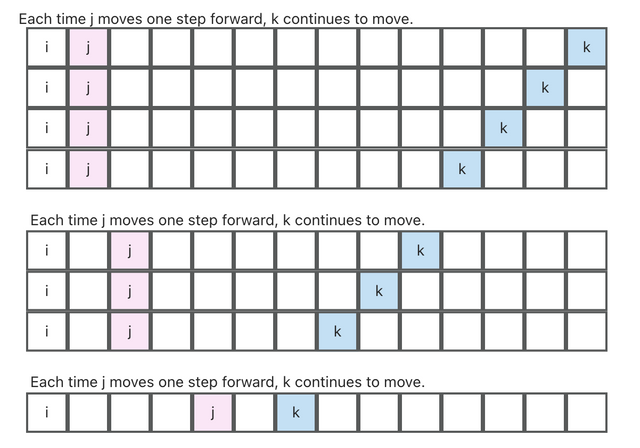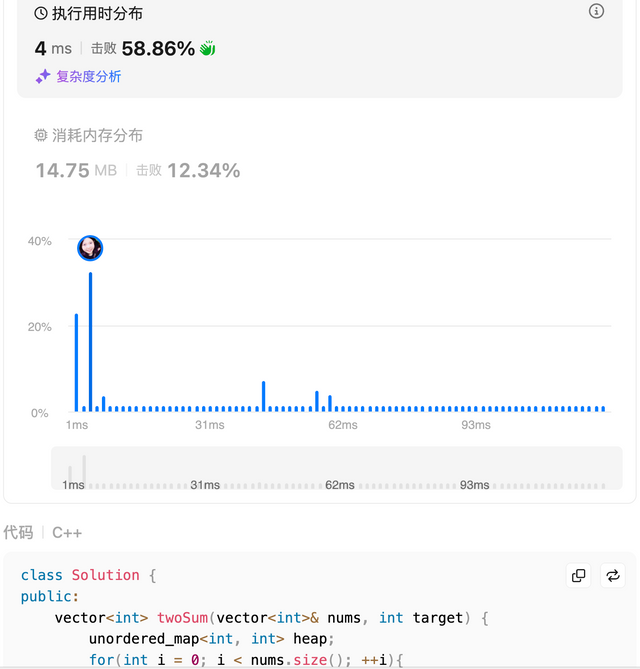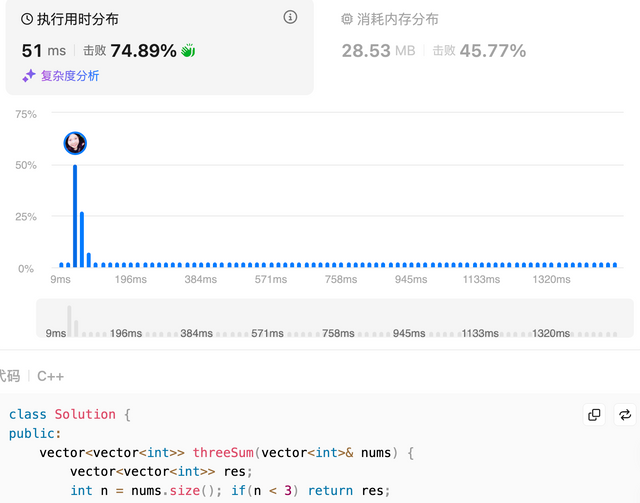daily practice
To keep my algorithm skill sharp so I don’t lose my touch, I’ve decided to solve a few algorithm problems every day (hopefully~) and track my progress here.
Today’s focus is on problems related to summing elements.
Two Sum
The difference of "Two Sum" from "Three Sum": "Three Sum" is sorted and uses the two-pointer technique.
Additionally, this problem requires using a map instead of a set because the problem asks for returning indices rather than values. Moreover, we are finding the corresponding index through the "value," so it's map<value, index>.
class Solution {
public:
vector<int> twoSum(vector<int>& nums, int target) {
unordered_map<int, int> heap;
for(int i = 0; i < nums.size(); ++i){
int r = target - nums[i];
if(heap.count(r)) return {heap[r], i};
heap[nums[i]] = i;
}
return {};
}
};
Three Sum
Sorting + Two Pointers
- Enumerate each number
nums[i]as a fixed value.- In the sorted array, use two pointers
j(starting fromi + 1) andk(starting fromn - 1) moving towards each other from both ends. - Find all valid triplets where
nums[i] + nums[j] + nums[k] == 0.
- In the sorted array, use two pointers
- During the search for valid triplets, let
sum = nums[i] + nums[j] + nums[k]:- If
sum > 0, movekto the left to decrease the sum. - If
sum < 0, movejto the right to increase the sum. - If
sum == 0, a valid triplet(nums[i], nums[j], nums[k])is found and added to the resultans.
- If
- Duplicate Handling:
class Solution {
public:
vector<vector<int>> threeSum(vector<int>& nums) {
vector<vector<int>> res;
int n = nums.size(); if(n < 3) return res;
sort(nums.begin(), nums.end()); // Don't forget: the prerequisite for the two-pointer technique is a sorted array.
for (int i = 0; i < n; i ++ ) {
if (i && nums[i] == nums[i - 1]) continue; //cannot be omitted, this is for deduplication. Semantics: i has already moved one step, and if it is the same as the previous nums[i-1], skip to the next, i.e., nums[i+1]
for (int j = i + 1, k = n - 1; j < k; j ++ ) { // Once i is fixed, proceed with the two-pointer algorithm for j and k.
// Common mistake: for (int j = i + 1; j < k; j ++ ) k should be initialized in the for-loop initialization, meaning inside for(), j and k always move closer.
if (j > i + 1 && nums[j] == nums[j - 1]) continue; //cannot be omitted, this is for deduplication. Semantics: j has already moved one step, and if it is the same as the previous nums[j-1], skip to the next, i.e., nums[j+1]
// Common mistake; int k = n - 1; same as line11, inside for(), j and k always move closer.
while (j < k && nums[i] + nums[j] + nums[k] > 0) k -- ;
// The reason while() does not check for sum < 0 is because if it is < 0, j++ is handled by the for(j++) in line8.
if (j < k && nums[i] + nums[j] + nums[k] == 0) { // Exiting while might be due to j>=k, so ensure j<k. If j==k, it might seem like two zeros (nums[j] == nums[k] == 0), but there is actually only one zero.
res.push_back({nums[i], nums[j], nums[k]});
}
}
}
return res;
}
};


